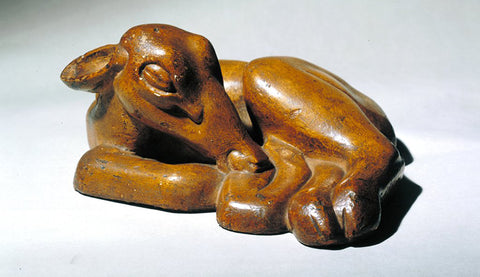Guest curator Dr Grace Brockington discusses Gaudier-Brzeska: Disputing the Earth

Gaudier-Brzeska: Disputing the Earth is an exhibition of works by French sculptor Henri Gaudier-Brzeska (1891-1915) taking place at the RWA from 16 March-2 June 2019. Despite his short life (he was killed in the First World War trenches at the age of 24), the artist had a major influence on 20th century art. Disputing the Earth will be the first show to examine the special significance that the animal kingdom held for the artist. Guest Curator Dr Grace Brockington talks to us about the exhibition...
1) Tell us about you
I’m Senior Lecturer in the History of Art at the University of Bristol. My department has an ongoing relationship with the RWA through teaching and exhibitions - our students regularly curate exhibitions at the RWA from the Academy’s historical collections. I was invited to act as Guest Curator on the exhibition because of my specialism in modern British art.
2) What can visitors expect to see at Gaudier-Brzeska: Disputing the Earth?
There will be about 30 works in the exhibition, comprising 10 sculptures, 2 sketchbooks, and a number of drawings. The main holdings of his work in this country are at Tate Britain and Kettle’s Yard, and these are our main lenders. We’ve also had loans from the V&A and from private collectors.
3) The exhibition is titled ‘Disputing the Earth’ - what's the meaning behind that?
It is a quotation from an article entitled ‘Vortex’ which Gaudier published in 1914, in the Vorticist magazine Blast. The full sentence is ‘Early stone-age man disputed the earth with animals.’ The article relates the history of art from pre-history to the present in terms of energy and sculptural form.
5) Gaudier-Brzeska had a very short life, killed in the trenches of WWI at 24 - and only worked for about 4 years, yet he produced a lot of work. Where do you think he stands in the story of 20th century sculpture and art more generally?
He is a significant figure because of the contribution that he made to early modernist movements - abstraction which began in 1911, direct carving in sculpture (also a development of the early twentieth century), Vorticism which was the radical wing of the British avant-garde, primitivism (he learnt a lot from the collections in the British Museum and the V&A). His work was noticed at the time by other artists (e.g. Jacob Epstein, Eric Gill, Percy Wyndham-Lewis), an influential critics such as Ezra Pound, Frank Rutter and Roger Fry. His posthumous reputation remained strong through the efforts of the collector Jim Ede (Kettles Yard), and holdings in major public galleries such as Tate, the Musee National d’Art Moderne in Paris, and the Musee des Beaux-Arts d’Orleans, so there was no question of him falling into obscurity after his death. As such - a perhaps because in part because of the tragedy of his early death - he has exerted an significant influence on later artists as the ‘Savage Messiah’ of British art.
6) What is Gaudier-Brzeska's connection to the RWA and Bristol?
There is a special connection between Gaudier and Bristol. As a teenager he spent nearly two years in the southwest, studying English business methods. His sketchbooks from the period feature studies of birds and animals from Bristol Zoo, Cardiff Museum and the surrounding countryside. Disputing the Earth brings Gaudier home to Bristol, a century after he first explored the city; and it establishes his significance as an animal artist at a moment when the idea of the Anthropocene is becoming newly important to the story of art.
7) Does sculpture get the public attention it deserves (compared to painting, with all its blockbuster exhibitions)?
Maybe not, for a variety of reasons. Economic - it’s harder to handle and transport, less easy to display in the average home. There’s been much debate in art circles about its relative merits. Connections with craftsmanship, decorative architecture, functional work like household pottery, has tended to give it a lower status.
Interested in reading more articles like this? Then join the Friends of the RWA. This piece is from from their quarterly newsletter—a publication exclusively for the Friends of the RWA containing articles, interviews and RWA news.
Interview conducted by Andrew Nixon, editor of the Friends of the RWA's arts blog The Floating Circle.